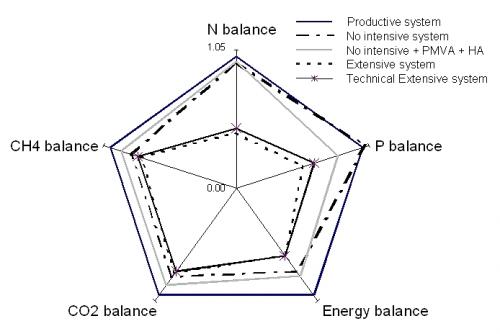Context
During the last decades, following the different problems involving more or less directly the agricultural sector, many questions concerning the sustainable character of this sector development, especially in the environmental (water pollution by nitrates or phosphates, loss of biodiversity, …) and social (food quality and security : use of hormones, crisis of the BSE, …) domains have emerged. This sustainable development is defined as « a development which meets the present needs without compromising the capacity of the future generations to meet their own needs » (Bruntland report, 1987).The principles of sustainable development, as recognized by the international community in 1992 in Rio, are based on an integration of economical, social and environmental aspects of human activities.The application of such a concept in agriculture corresponds to the definition of farming systems that are economically viable (good economical efficiency of the production process and system transmissibility), ecologically safe (preservation or improvement of natural resources) and socially equitable.
To meet these expectations, the farmer must maintain its system in a permanent evolution. But in which direction? Which are the alternatives ?
In order to give correct advices to the farmers, a general knowledge of agriculture as well as of its economic, ecological and social environment is necessary. Which tools are available to model the possible ways of farming systems evolutions, under constraints ? How can we transmit this information in a clear way and without ambiguity?
Objectives
The aim of this project is to model farming systems i.e. to describe in a simple but complete way the technical itineraries used by the farmers to manage their exploitation. To do so, we model, through experts knowledge, the way in which the production factors (buildings, inputs and outputs, know-how, …) are associated within technical itineraries in order to maintain or develop their system of production. On the basis of these itineraries, we can translate the sustainable character of the exploitations using indicators resulting from different methods (ECO-FERME, IDEA, …), according to the desired dimension (economic, ecologic or social).
The data used to achieve this objective come from farms accountancies (structural constraints, production factors, flux,…) and from exploitations surveys aiming to define the way in which the factors of production are associated and to apprehend the different sustainability dimensions. Based on these data we define a typology of the farming systems included in the territory under analysis together with their management modes. The comparison of the different technical itineraries while optimising economical, ecological and social performances allows the identification of strong and weak points of the systems under analysis together with the definition, by modelling, of different evolution ways.
Expected results
Based on all these results, we develop a decision support tool, for the political and local decision maker just like farmer. This tool makes it possible to model livestock farming systems located in the southern part of Wallonia in order to be able to define the possible answers, options, in the form of scenario, which offer themselves to these systems to face the compulsory territorial constraints. Such a model will make it possible to define the impact of these constraints on the environmental, economical and social sustainable character of these systems.
Results obtained
This methodology was applied to different spatial scales in order to characterize the farming system diversity and to define in which way their technical itineraries and, consequently, their externalities, can evolve to better answer different types of constraints.
So the aim of the Interreg II Project was to describe the farming systems in the Wallonnie-Champagne-Ardennes area, having huge soil and climatic similarities paired to socio-political contrasts. These contrasts have led to different farming systems evolution (size of the exploitations, level of system intensification, …) producing similar incomes. On the basis of the 60 exploitations (30 Belgians and 30 Frenchs), specialized in animal production, we have described ahead 6 large types of systems (3 per country).
Thereafter we have detailed the “Suckling system based on grassland” of the Luxemburg province (Belgium). We have modelled some ways of evolution for this system to take the CAP changes into account, especially concerning the transfer of at least 15% of the 'suckling' premium on the heifers. In addition to the reference system (productive system), 4 alternatives were imagined : (1) the sale of the cows without support, (2) the purchase of additional ‘subsidies right’ and hectares to have less than 1,8 UGBprimed/ha (+PMVA+HA), (3) the transfer of 25% of the premiums on the heifers and the sale of the cows without supports (Extensive system) and (4) to perform first calving at 24 months and to sale the cows without supports (technical extensive system). This last system presents the highest economical and ecological performances but requires a more important technical knowledge and know how of the farmer (fig. 1).
In another study, we analysed the impacts of lands regrouping on livestock farming systems ecological and social sustainability. To reach such a target we compared exploitations with and without land regrouping in the areas of Couvreux and Clavier. The results underlined an intensification of the systems with regrouped lands. However, this intensification is associated with more sustainable practices like the combination of mowing and grazing on the greatest part of grassland surfaces. Indeed, a greater part of these grasslands is accessible and can be grazed but N fertilization often remains to be optimised.
For the moment this methodology is applied to specialized dairy exploitations in order to adapt their practices to the nitrate directive.
Contribution
The farming Systems Section coordinates and is the main actor for all of these actions.
Within the development of the OptiMAE tool, we are working in collaboration with the Biometry Section, Data management and Agrometeorology.
Partners
Technico-economical services from the Walloon Breeding Association (AWE-STE) and from the Provincial services of agricultural management, information and popularisation (SPIGVA-DER).
The Breeding Institute in France.
The NITRAWAL Scientist partners.
The Unit of fluid behaviour and the environment (FUSAGx).
CRAW off coordinator
Ir GHYSEL François & Ir. HENNART Sylvain
CRA-W - Section Systèmes agricoles
Rue de Serpont, 100
B-6800 Libramont
Tél : + 32 (0) 61 / 23.10.10
Fax : + 32 (0) 61 / 23.10.28
Email : f.ghysel@cra.wallonie.be; hennart@cra.wallonie.be
Funding
- CE - Regional politics - INTERREG II
- CRA-W - Walloon Agricultural Research Centre
- DGARNE





